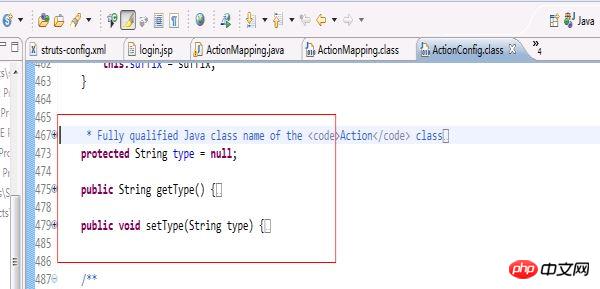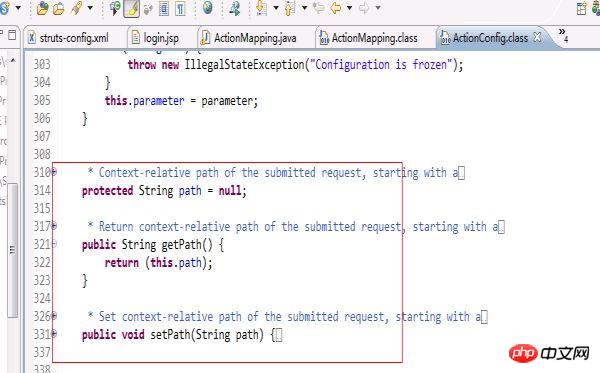ホームページ >Java >&#&チュートリアル >Struts1 ActionMappingの例の説明
Struts1 ActionMappingの例の説明
- 巴扎黑オリジナル
- 2017-09-06 09:34:421799ブラウズ
この記事では主に Struts1 チュートリアルの ActionMapping を紹介します。編集者はそれを参考として共有します。エディターに従って見てみましょう
まず、ブレークポイントは processpath メソッドの外にあります
今日は、ActionMapping を取得する方法を見ていきます。メソッド---プロセスマッピング。  その前に、ActionMapping について簡単に説明します。ソース コードから、最も重要な属性は、主に対応する Struts のパス、type、forwardMap に似ていることがわかります。 config 設定ファイル。これは、この設定ファイルの情報をメモリに保存します。
その前に、ActionMapping について簡単に説明します。ソース コードから、最も重要な属性は、主に対応する Struts のパス、type、forwardMap に似ていることがわかります。 config 設定ファイル。これは、この設定ファイルの情報をメモリに保存します。
特定の mvc small インスタンスの ActionMapping コードは次のとおりです:
package com.cjq.servlet;
import java.util.Map;
public class ActionMapping {
private String path;
private Object type;
private Map forwardMap;
public String getPath() {
return path;
}
public void setPath(String path) {
this.path = path;
}
public Object getType() {
return type;
}
public void setType(Object type) {
this.type = type;
}
public Map getForwardMap() {
return forwardMap;
}
public void setForwardMap(Map forwardMap) {
this.forwardMap = forwardMap;
}
} そして、Struts の Actionconfig のコード (ActionMapping はこの ActionConfig を継承するため、ActionConfig をより直接的に調べます) は次のとおりです: 

 ActionMapping の内容についていくつか説明したので、ActionMapping についてはある程度理解できたと思います。それでは、システムはどのように ActionMapping を生成し、どのようにして ActionMapping を見つけるのでしょうか?これが今日話したいことのすべてです:
ActionMapping の内容についていくつか説明したので、ActionMapping についてはある程度理解できたと思います。それでは、システムはどのように ActionMapping を生成し、どのようにして ActionMapping を見つけるのでしょうか?これが今日話したいことのすべてです:
Web で 4781e2cbaa93c386271b418d3a01af0823065abc64b27fbca30c0905ab93e8ea0 の構成情報を見てみましょう。 struts-config 構成ファイルを読み取ります。そして設定ファイルの情報をActionMappingに入力します。したがって、サーバーを実行すると、struts-config 構成ファイルの情報に対応する ActionMapping がメモリ内にすでに存在します。今日は、processMapping を通じてこの ActionMapping クラスを読み取ります。
ブレークポイントのデバッグに入り、最初に processMapping メソッドにブレークポイントを設定します。
/**
* <p>Select the mapping used to process theselection path for this request
* If no mapping can be identified, createan error response and return
* <code>null</code>.</p>
*
* @param request The servlet request weare processing
* @param response The servlet response weare creating
* @param path The portion of the requestURI for selecting a mapping
*
* @exception IOException if an input/outputerror occurs
*/
protectedActionMapping processMapping(HttpServletRequestrequest,
HttpServletResponse response,
String path)
throws IOException {
// Is there a mapping for this path?
ActionMapping mapping = (ActionMapping)
moduleConfig.findActionConfig(path);
// If a mapping is found, put it in the request and return it
if (mapping != null) {
request.setAttribute(Globals.MAPPING_KEY, mapping);
return (mapping);
}
// Locate the mapping for unknown paths (if any)
ActionConfig configs[] = moduleConfig.findActionConfigs();
for (int i = 0; i < configs.length; i++) {
if (configs[i].getUnknown()) {
mapping = (ActionMapping)configs[i];
request.setAttribute(Globals.MAPPING_KEY, mapping);
return (mapping);
}
}
// No mapping can be found to process this request
String msg = getInternal().getMessage("processInvalid");
log.error(msg + " " + path);
response.sendError(HttpServletResponse.SC_NOT_FOUND, msg);
return null;
} まず、前のステップでインターセプトしたパスを渡し、moduleConfig の findAction メソッドで ActionConfig を検索し、ActionMapping を返します。具体的なコードは次のとおりです: ActionMapping mapping =(ActionMapping) moduleConfig.findActionConfig(path);見つかった場合、ActionMapping はリクエストのコンテキストに保存されます。コード:
if (mapping != null) {
request.setAttribute(Globals.MAPPING_KEY, mapping);
return (mapping);
} パスでマッピングが見つからない場合は、Actionconfig を走査して不明なパスのマッピングを見つけます。見つかった場合は、リクエストに保存されます。見つからない場合は、エラー メッセージが表示されます。具体的なコードは次のとおりです。
// Locate the mapping for unknownpaths (if any)
ActionConfig configs[] = moduleConfigfindActionConfigs();
for (int i = 0; i < configslength; i++) {
if (configs[i].getUnknown()) {
mapping = (ActionMapping)configs[i];
request.setAttribute(Globals.MAPPING_KEY, mapping);
return (mapping);
}
}
// No mapping can be found to process this request
String msg = getInternal().getMessage("processInvalid");
log.error(msg + " " + path);
response.sendError(HttpServletResponse.SC_NOT_FOUND, msg);
return null; 文字列をインターセプトし、その文字列に基づいて ActionMapping を取得するときの processActionForm を見てみましょう (これは最初の 2 つで紹介されています)。記事)、ActionMapping を使用して ActionForm を作成し、その ActionForm をリクエストまたはセッションに入れて管理します。 /**
* <p>Retrieve and return the <code>ActionForm</code> associatedwith
* this mapping, creating and retaining oneif necessary. If there is no
* <code>ActionForm</code> associated with this mapping,return
* <code>null</code>.</p>
*
* @param request The servlet request weare processing
* @param response The servlet response weare creating
* @param mapping The mapping we are using
*/
protectedActionForm processActionForm(HttpServletRequestrequest,
HttpServletResponse response,
ActionMapping mapping) {
// Create (if necessary) a form bean to use
ActionForm instance = RequestUtilscreateActionForm
(request, mapping, moduleConfig, servlet);
if (instance == null) {
return (null);
}
// Store the new instance in the appropriate scope
if (log.isDebugEnabled()) {
log.debug(" Storing ActionForm bean instance in scope '" +
mapping.getScope() + "' under attribute key '" +
mapping.getAttribute() + "'");
}
if ("request".equals(mapping.getScope())) {
request.setAttribute(mapping.getAttribute(), instance);
} else {
HttpSession session =requestgetSession();
session.setAttribute(mapping.getAttribute(), instance);
}
return (instance);
} このメソッドの一般的なプロセスは次のとおりです: ActionMapping の名前に基づいて ActionForm を検索します。ActionForm が設定されている場合は、リクエストに進みます。またはセッションを検索すると、リクエストまたはセッション内に作成された ActionForm が存在する場合、それが返されます。存在しない場合は、ActionForm の完了パスに従ってリフレクションを使用して作成され、作成された ActionForm がリクエストまたはセッションに配置され、ActionForm が返されます。 // Create (if necessary) a formbean to use
ActionForm instance = RequestUtils.createActionForm
(request, mapping, moduleConfig, servlet);
if (instance == null) {
return (null);
} RequestUtils.createActionForm メソッドを呼び出して、ActionMapping の ActionForm 文字列からオブジェクトを生成し、それを返します。次のコードを入力します: publicstaticActionForm createActionForm(
HttpServletRequest request,
ActionMapping mapping,
ModuleConfig moduleConfig,
ActionServlet servlet) {
// Is there a form bean associated with this mapping?
String attribute = mappinggetAttribute();
if (attribute == null) {
return (null);
}
// Look up the form bean configuration information to use
String name = mapping.getName();
FormBeanConfig config =moduleConfigfindFormBeanConfig(name);
if (config == null) {
log.warn("No FormBeanConfig found under '"+ name + "'");
return (null);
}
ActionForm instance = lookupActionForm(request,attribute, mappinggetScope());
// Can we recycle the existing form bean instance (if there is one)?
try {
if (instance != null && canReuseActionForm(instance,config)) {
return (instance);
}
} catch(ClassNotFoundException e) {
log.error(servlet.getInternal().getMessage("formBean",config.getType()), e);
return (null);
}
return createActionForm(config,servlet);
} メソッドは、最初に変数名を定義し、インスタンスの LoginForm 文字列である String name = Mapping.getName(); から値を取得します。その後、FormBeanConfig config =moduleConfig.findFormBeanConfig(name); を呼び出すことにより、対応する LoginForm 文字列が対応するオブジェクトに生成されます。 <form-beans>
<form-bean name="loginForm" type=".struts.LoginActionForm"/>
</form-beans>这个标签在服务器一启动的时候就会利用digester读取这里的配置信息,并且放在FormBeanConfig类中,这样我们可以通过上面那一句话就可以把LoginForm字符串生成相应的对象。
之后调用了ActionForm instance = lookupActionForm(request,attribute, mapping.getScope());这个方法,这个方法主要是查找scope属性中有没有存在ActionForm。具体实现:
if ("request".equals(scope)){
instance = (ActionForm)request.getAttribute(attribute);
} else {
session = request.getSession();
instance = (ActionForm)session.getAttribute(attribute);
}这里判断scope属性值是否为request,如果是则从request中读出ActionForm,如果不是则从session中读出。程序如果是第一次执行,那么ActionForm会是为空的。因为这里的ActionForm为空,所以就进入了if判断语句中,最后通过调用return createActionForm(config, servlet);创建ActionForm并且返回。
之后processActionForm就会把返回来的ActionForm放入request或者session中。具体实现就是:
if ("request".equals(mapping.getScope())){
request.setAttribute(mapping.getAttribute(), instance);
} else {
HttpSession session =request.getSession();
session.setAttribute(mapping.getAttribute(), instance);
}到此为止,ActionForm就创建完成,当ActionForm创建完成之后,就要用其他的方法来往ActionForm中赋值了
以上がStruts1 ActionMappingの例の説明の詳細内容です。詳細については、PHP 中国語 Web サイトの他の関連記事を参照してください。

